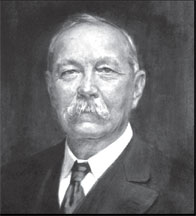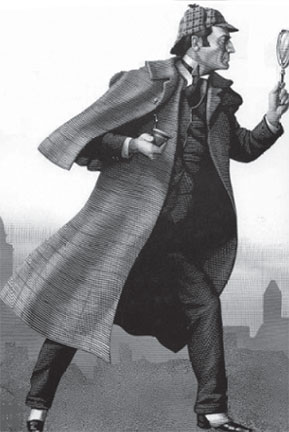Sherlock Holmes and Arthur Conan Doyle
By Amal Hewavissenti
The fictional detective Sherlock Holmes shoots to widespread éclat
and popularity once England's detectives find themselves lamentably
powerless against the growing problem of crime wave. His inherently
inquisitive nature compels him to probe carefully on any trivial
incident because most organised crimes in England daily go into the list
of unresolved mysteries.
 |
|
Arthur Conan Doyle |
Confronted with the growing criminality, Sherlock Holmes equips
himself with a sharp wit and an eagle eye which sweeps a scene of crime
and instantly gathers clues which an average person is incapable of
getting even after months of investigation.
Therefore, in Arthur Conan Doyle's fiction, Sherlock Holmes becomes
the most dependable man when a particular crime begins to fade into a
mystery as he has already shown his mettle in unravelling criminal
mysteries. In the first place Sherlock Holmes and his ‘resolutions of
crimes’ are totally fictitious even though readers are constantly
obsessed by the question whether the accounts of famous Sherlock Holmes
are closer to reality.
Once Conan Doyle assertively expressed that fictional Sherlock Holmes
was largely prototypical of Dr. Joseph Bell who actually used to arrive
at precise conclusions even from vague clues. (Above all, Dr. Joseph
Bell was a living character that inspired Conan Doyle to create the
legendary detective hero.)
When Conan Doyle was employed at the Royal Hospital of Edinburgh, he
gained the valuable companionship of Joseph Bell who was prominently
enthusiastic about solution of crimes and gave his support for the
police to solve criminal mysteries.
Sir Arthur Conon Doyle's Sherlock Holmes is a strange detective
addicted, to some extent, to morphine and cocaine.
|Sherlock Holmes is a silent actor and has the capacity to capture
criminals by means of dramatically set up traps and strategies. In
dramatic scenes, Holmes rationally presents clues and his own
discoveries to the total astonishment of those associated with the
particular case.
Here, in partnership with Watson, Holmes reveals the exciting truth
of the crime on the finals stage. He vividly describes his own procedure
of detecting a crime with ample illustrations and calculates when and
how a particular death has occurred with pinpoint accuracy.
Holmes communicates more with Watson than with police and assumes
authority and becomes over bearing with police officers. On successful
resolutions of crimes he is gifted with a golden casket by King
Barnimia, a valuable stamp from Scandinavian royalty, a sapphire from
Queen Victoria, a gold ring from Irine Addler.
Among the women he has encountered, Irine Addler, becomes the centre
of attraction for Holmes, according to Watson's accounts - a fact that
is evident through many of Holmes’s references to people. Watson's words
corroborates the idea that Sherlock Holmes has sharply fallen in love
with her even though he has made no direct revelation of his emotions.
 In 2006, Copplester made a scientific research about the criminal
investigation methods used by Holmes during the nineteenth century.
Copplester's conclusion was that Holmes’s intellectual level lay on a
higher elevation and his methodology appeared to be far more advanced
for the nineteenth century Europe. In 2006, Copplester made a scientific research about the criminal
investigation methods used by Holmes during the nineteenth century.
Copplester's conclusion was that Holmes’s intellectual level lay on a
higher elevation and his methodology appeared to be far more advanced
for the nineteenth century Europe.
Sherlock Holmes is a series of fictitious detective stories written
and published rather unsuccessfully in 1886 by the title of “Blood Test”
- the first Sherlock Holmes’ story that met with inadequate public
response. Previously Conan Doyle had given the story to magazine editors
for publication, but he was soon disappointed by the low recognition
given by them to the story.
After much effort, Conan Doyle was able to get his first Sherlock
Holmes’ story published in the magazine Strand and the Doctor in Arthur
Conan Doyle was excelled by the writer in him. Sir Arthur Conan Doyle
earned twenty-five pounds from the first Sherlock Holmes’ story “Blood
Test” published in the magazine.
Memorable
Most memorable of his Sherlock Holmes’ stories include “Memoirs of
Sherlock Holmes”, “The Hound of the Baskervilles”, “Blood Test” and
“Sherlock Homes Returns”. When Conan Doyle was fed up with writing
Sherlock Holmes’ stories, he tried to make his fans oblivious to Holmes,
but they insisted that he writes more detective stories. Therefore Conan
Doyle was forced to continue the series of Holmes detective stories with
“Sherlock Holmes Returns”.
It is interesting to note that “Sherlock Holmes Club’ was officially
launched in 1934 at Bakers Street which was identical with the “Bakers
Street” in Arthur Conan Doyle's fiction. The club was established with
the support from Sherlock Holmes fans and scholars and was meant for
those aspiring to become detectives and for enthusiasts of crime
detection. In 1951, Sherlock Holmes Museum was established on Bakers
Street in London as the world's first museum for a fictitious character.
Sir Arthur Conan Doyle's The Lost World is centred on a different
theme. It is a tale of adventure that narratives horrible experience
with prehistoric Dinosaurs that reappeared in Amazon Forest. Arthur
Conan Doyle was a renowned soccer player, and a cricketer and showed
special interest in golf. The mansion rebuilt in London was subsequently
transferred into a tourist resort which is currently dedicated for the
benefit of his fans.
|



